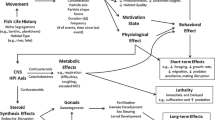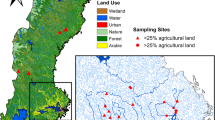Abstract
In river catchments, sediment fluxes facilitate the transport of nutrients and pollutants and reduce water quality, potentially impacting water body health and altering ecosystem functioning. Sediment transport processes also modify the morphology of catchments, and sediment deposition can reduce flow capacity in rivers and water storage capacity in reservoirs and lakes. In this paper, estimates of suspended sediment yields and concentrations in the South Saskatchewan River catchment located in western Canada are presented. The results stem from a SPARROW model, which indicates that the dominant sources of sediment are represented by agricultural fields and urbanized lands. Analyses of sediment retention in the major catchment reservoirs indicate that, as expected, reservoir storage capacity is negatively correlated with reservoir storage reduction and positively correlated with retention rate. Additionally, reservoir lifespans range from less than 100 years to over 9000 years. The results presented here will be useful to complement local environmental guidelines to allow better management of sediment erosion and deposition in the South Saskatchewan River catchment.





Similar content being viewed by others
References
Alberta Environment & Sustainable Resource Development (ESRD). 2014. Environmental quality guidelines for Alberta surface waters. Water policy branch, Policy Division, Edmonton. p 48
Alexander RB, Elliott AH, Shankar U, McBride GB (2002) Estimating the sources and transport of nutrients in the Waikato River Basin, New Zealand. Water Resour Res 38(12):4-1–4-23
Ashmore PE, Day TJ (1988a) Spatial and temporal patterns of suspended-sediment yield in the Saskatchewan River basin. Can J Earth Sci 25(9):1450–1463
Ashmore PE, Day TJ (1988b) Effective discharge for suspended sediment transport in streams of the Saskatchewan River basin. Water Resour Res 24(6):864–870
Borrelli P, Märker M, Schütt B (2015) Modelling post-tree-harvesting soil erosion and sediment deposition potential in the Turano River basin (Italian central Apennine). Land Degrad Dev 26(4):356–366
Brakebill JW, Ator SW, Schwarz GE (2010) Sources of suspended sediment flux in streams of the Chesapeake Bay watershed: a regional application of the SPARROW Model1. J Am Water Resour Assoc 46(4):757–776
Correll DL (1998) The role of phosphorus in the eutrophication of receiving waters: a review. J Environ Qual 27(2):261–266
Daly C, Neilson RP, Phillips DL (1994) A statistical-topographic model for mapping climatological precipitation over mountainous terrain. J Appl Meteorol 33(2):140–158
Davis JR, Koop K (2006) Eutrophication in Australian rivers, reservoirs and estuaries–a southern hemisphere perspective on the science and its implications. Hydrobiologia 559(1):23–76
Duan WL, He B, Takara K, Luo PP, Nover D, Hu MC (2015) Modeling suspended sediment sources and transport in the Ishikari River basin, Japan, using SPARROW. Hydrol Earth Syst Sci 19(3):1293–1306
Fisher TR, Harding LW, Stanley DW, Ward LG (1988) Phytoplankton, nutrients, and turbidity in the Chesapeake, Delaware, and Hudson estuaries. Estuar Coast Shelf Sci 27(1):61–93
Forman RT, Alexander LE (1998) Roads and their major ecological effects. Annu Rev Ecol Syst 29:207–231
Franz C, Makeschin F, Weiß H, Lorz C (2014) Sediments in urban river basins: identification of sediment sources within the Lago Paranoa catchment, Brasilia DF, Brazil–using the fingerprint approach. Sci Total Environ 466:513–523
Frenette M, Julien PY (1996) Physical processes governing reservoir sedimentation. In: Proceedings of the international conference on reservoir sedimentation, vol 2, sec
Gill MA (1979) Sedimentation and useful life of reservoirs. J Hydrol 44:89–95
Gurnell AM, Bertoldi W, Corenblit D (2012) Changing river channels: the roles of hydrological processes, plants and pioneer fluvial landforms in humid temperate, mixed load, gravel bed rivers. Earth Sci Rev 111(1):129–141
Hairsine PB, Rose CW (1991) Rainfall detachment and deposition: sediment transport in the absence of flow-driven processes. Soil Sci Soc Am J 55(2):320–324
Heathwaite AL, Johnes PJ (1996) Contribution of nitrogen species and phosphorus fractions to stream water quality in agricultural catchments. Hydrol Process 10(7):971–983
Helsel DR, Hirsch RM (1992) Statistical methods in water resources, vol 49. Elsevier, Amsterdam
Henley WF, Patterson MA, Neves RJ, Lemly AD (2000) Effects of sedimentation and turbidity on lotic food webs: a concise review for natural resource managers. Rev Fish Sci 8(2):125–139
Hudson HR, Askin RW (1987) An interpretive study of the upper Oldman River sediment regime. Sediment Survey Section, Water Survey of Canada, Water Resources Branch, Inland Waters Directorate, Environment Canada, Report IWD-WNR(A)-WRBSS-87-3
Jeje Y (2006) Export coefficients for total phosphorus, total nitrogen and total suspended solids in the Southern Alberta region – a review of literature. Available from http://environment.gov.ab.ca/info/library/7797.pdf, 2006. Accessed 20 Sept 2017
McIntyre SC (1993) Reservoir sedimentation rates linked to long-term changes in agricultural land-use. J Am Water Resour Assoc 29(3):487–495
McPherson HJ (1975) Sediment yields from intermediate-sized drainage basins in southern Alberta. J Hydrol 25:243–257
Mihaljević M, Špoljarić D, Stević F, Cvijanović V, Kutuzović BH (2010) The influence of extreme floods from the river Danube in 2006 on phytoplankton communities in a floodplain lake: shift to a clear state. Limnol-Ecol Manag Inland Waters 40(3):260–268
Morales-Marín L, Wheater H, Lindenschmidt KE (2015) Assessing the transport of total phosphorus from a prairie river basin using SPARROW. Hydrol Process 29(18):4144–4160
Morales-Marín LA, Wheater HS, Lindenschmidt KE (2017) Assessment of nutrient loadings of a large multipurpose prairie reservoir. J Hydrol 550:166–185
Morris GL, Fan J (1998) Reservoir sedimentation handbook: design and management of dams, reservoirs, and watersheds for sustainable use. McGraw Hill Professional, New York
Mossa J (1996) Sediment dynamics in the lowermost Mississippi River. Eng Geol 45(1):457–479
Quinn JM, Stroud MJ (2002) Water quality and sediment and nutrient export from New Zealand hill-land catchments of contrasting land use. N Z J Mar Freshw Res 36(2):409–429
Rose CW (1993) Erosion and sedimentation. In: Bonell M, Hufschmidt MM, Gladwell JS (eds) Hydrology and Water Management in the Humid Tropics: Hydrological Research Issues and Strategies for Water Management. Cambridge University Press, Cambridge, pp 301–343
Sadeghian A, de Boer D, Lindenschmidt KE (2017) Sedimentation and erosion in Lake Diefenbaker, Canada: solutions for shoreline retreat monitoring. Environ Monit Assess 189(10):507
Schwarz GE (2008) A Preliminary SPARROW model of suspended sediment for the conterminous United States: U.S. Geological Survey Open-File Report 2008–1205, 8 p., available only online at http://pubs.usgs.gov/of/2008/1205
Shaw J, Kellerhals R (1982) The composition of recent alluvial gravels in Alberta river beds, Bull. 41. Alberta Geol. Surv., Edmonton, AB, Canada, pp 151
Slaymaker HO (1972) Sediment yield and sediment control in the Canadian Cordillera. In Slaymaker HO, McPherson HJ (eds) Mountain geomorphology, B.C. Geographical Series, No. 14. Tantalus Research, Vancouver, pp 235–245
Smith CD, Wigham JM (1989) Erosion and sedimentation in the South Saskatchewan River Basin. Report to Saskatchewan Water Corporation, p 100. plus Appendix
Smith RA, Schwarz GE, Alexander RB (1997) Regional interpretation of water-quality monitoring data. Water Resour Res 33(12):2781–2798
Stichling W (1973) Sediment loads in Canadian rivers. In: Fluvial processes and sedimentation, Proceedings, Hydrology Symposium, The University of Alberta, Edmonton, Alta, May 1973, pp 39–72
Van Rijn LC (1993) Principles of sediment transport in rivers, estuaries and coastal seas, vol 1006. Aqua publications, Amsterdam
Acknowledgements
This study was funded by the University of Saskatchewan’s Global Institute for Water Security through the Canada Excellence Research Chair in Water Security (CERC).
Author information
Authors and Affiliations
Corresponding author
Rights and permissions
About this article
Cite this article
Morales-Marín, L.A., Wheater, H.S. & Lindenschmidt, K.E. Estimating Sediment Loadings in the South Saskatchewan River Catchment. Water Resour Manage 32, 769–783 (2018). https://doi.org/10.1007/s11269-017-1838-8
Received:
Accepted:
Published:
Issue Date:
DOI: https://doi.org/10.1007/s11269-017-1838-8




